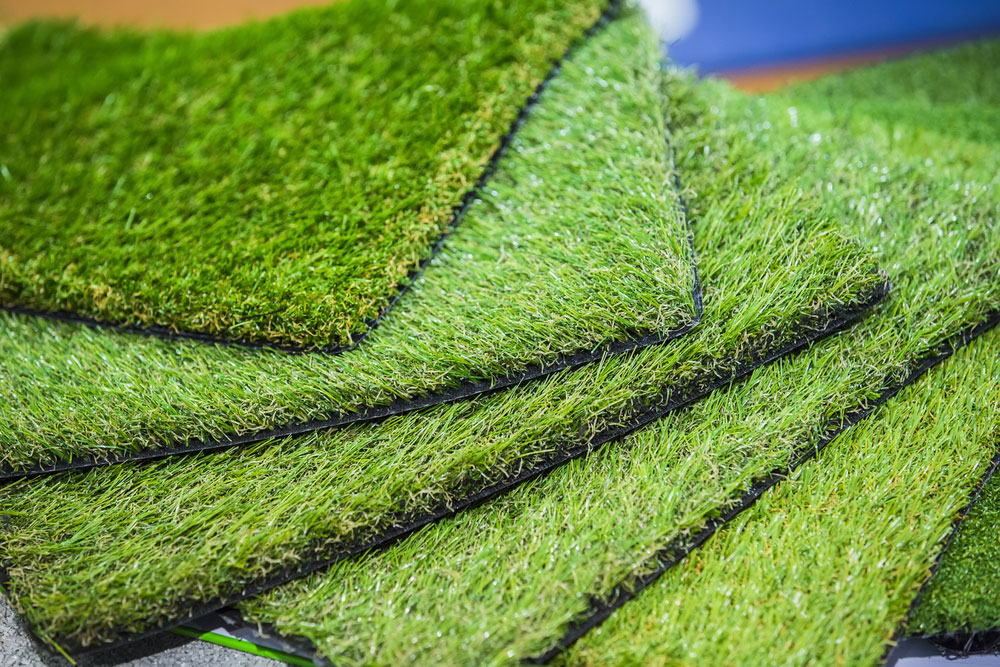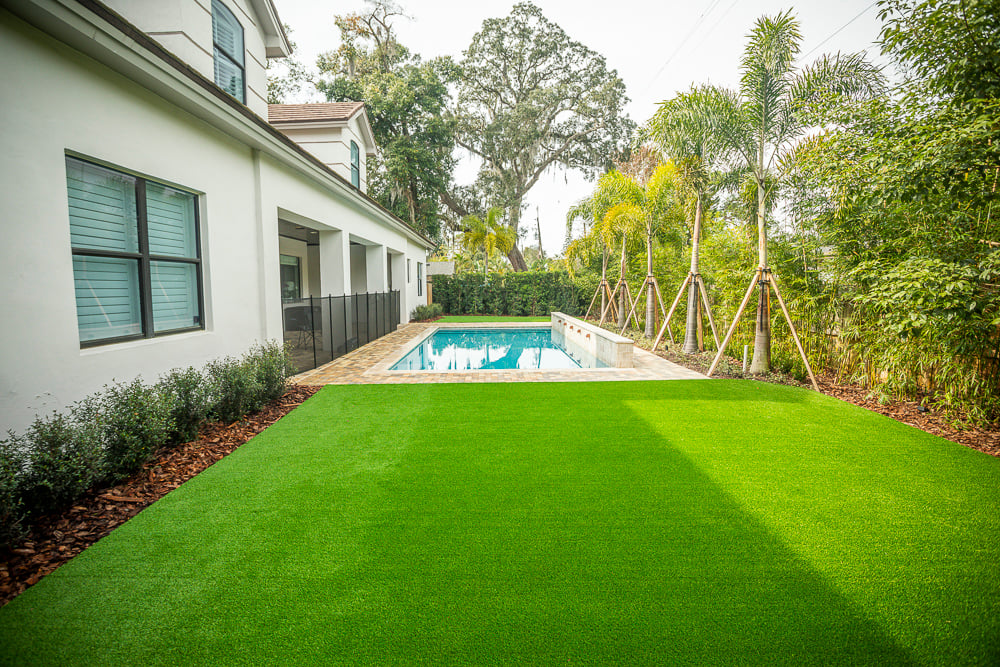See Why Homeowners Prefer Artificial Turf for Lasting Landscape Design Practices
As homeowners increasingly prioritize sustainability in landscape design, synthetic grass has actually emerged as an engaging choice to standard turf. Its capability to preserve water, minimize upkeep initiatives, and lessen ecological effect settings it as a functional selection for those seeking environmentally friendly remedies. Moreover, the visual appeal and versatility of synthetic grass accommodate diverse design preferences. Nonetheless, the ramifications of this change prolong beyond simple convenience and aesthetic appeals, triggering a closer examination of exactly how these options affect wider environmental end results. What remains to be explored is the full range of advantages that synthetic grass can supply to property owners and the setting alike.
Water Conservation Conveniences
One of the most considerable benefits of fabricated lawn is its duty in water preservation. In comparison, synthetic lawn removes this demand totally, as it does not need watering.
In addition, the installation of synthetic grass can add to a much more lasting landscape. Home owners can significantly reduce their water expenses, enabling for reallocation of sources to other ecological campaigns or house usages. In addition, artificial lawn is developed to endure various weather conditions without the need for additional watering, making it a suitable selection for areas dealing with water deficiency.
The environmental benefits extend beyond instant water financial savings. By decreasing water consumption, fabricated lawn aids to minimize the effects of climate modification, preserving vital ecological communities that are threatened by extreme water removal. As sustainable landscaping methods get traction, synthetic grass becomes a liable option for home owners seeking to create environmentally friendly outside rooms.
Decreased Maintenance Initiatives
Synthetic grass dramatically decreases maintenance initiatives contrasted to typical yard lawns. With man-made turf, homeowners can eliminate the lengthy jobs connected with all-natural landscape design, such as mowing, fertilizing, and weeding. This not only saves useful time but likewise decreases physical labor, making yard treatment accessible for people of every ages.
Standard grass need regular trimming to maintain a cosmetically pleasing height, whereas fabricated turf continues to be constantly rich without the requirement for reducing. Furthermore, home owners no much longer require to use pesticides or fertilizers, which are usually required to maintain all-natural yard healthy and balanced.
Moreover, man-made lawn is resilient and sturdy, requiring minimal upkeep beyond occasional brushing and washing to eliminate particles. This convenience of maintenance permits home owners to appreciate their outdoor areas without the constant worry of maintenance, giving even more time for recreation and family activities. Inevitably, the decreased upkeep initiatives associated with fabricated lawn make it an appealing option for those looking for a low-maintenance, aesthetically appealing landscape.

Environmental Effect Reduction
There is an expanding recognition of the environmental benefits linked with synthetic grass, specifically in terms of water preservation and decreased chemical use. Typical lawns require considerable amounts of water, specifically in drought-prone regions, leading to boosted stress on neighborhood water sources. On the other hand, synthetic lawn eliminates the demand for irrigation, drastically reducing water intake and promoting sustainability.
In addition, traditional yard upkeep usually includes the application of chemicals, herbicides, and plant foods, which can add to dirt and water air pollution. Man-made grass minimizes this ecological threat by needing marginal maintenance and essentially getting rid of the requirement for hazardous chemicals. This not only enhances soil wellness but additionally safeguards regional ecological communities from poisonous overflow.
In addition, the manufacturing of all-natural grass lawns normally entails the use of nonrenewable fuel sources for cutting and landscaping devices, more adding to greenhouse gas emissions. By choosing fabricated turf, homeowners can significantly reduce their carbon impact linked with grass treatment tasks.
Visual Appeal and Convenience
Along with its environmental advantages, synthetic lawn supplies substantial visual appeal and flexibility for landscape design. Home owners can achieve a lush, eco-friendly appearance year-round, eliminating the seasonal variations typically related to natural yard. This consistent aesthetic not just improves the visual allure of a property but also adds to a properly maintained and polished look.
In addition, synthetic grass is available in a variety of appearances, shades, and designs, enabling modification to fit private preferences and style styles - Arizona artificial turf. Whether made use of in residential gardens, commercial rooms, or leisure areas, it can effortlessly like it incorporate right into diverse landscape design styles, from modern-day minimalist to lavish exotic settings
The flexibility of man-made turf prolongs beyond simple look; it can be set up in various locations, consisting of rooftops, patios, and also interior areas, creating possibilities for special landscaping remedies. Additionally, it appropriates for a series of activities, from kids's play areas to pet-friendly settings, providing performance without jeopardizing style.
Eventually, the visual charm and versatility of synthetic grass make it an eye-catching alternative for house owners seeking sustainable landscape design solutions that do not sacrifice charm for ecological duty.

Long-Term Price Cost Savings
One of the most compelling benefits of artificial grass is its capacity for long-term cost financial savings. Unlike natural lawn, which requires routine maintenance-- consisting of mowing, watering, fertilizing, and bug control-- fabricated lawn significantly lowers these recurring costs.
Additionally, synthetic grass has a life expectancy of 15 to 25 years, relying on its high quality and usage. This longevity minimizes substitute prices, making it a more affordable choice in the future. Moreover, the first financial investment in artificial turf can typically be redeemed via the cost savings accumulated gradually.
While the ahead of time expense might seem higher compared to turf setup, the advancing cost savings from reduced upkeep and water use usually exceed these initial expenses. Ultimately, the adoption of synthetic grass not just advertises a lasting landscape design service yet additionally uses property owners a monetarily smart alternative that aligns with lasting budgeting goals.
Verdict
Artificial lawn arises as a compelling alternative for lasting landscaping, supplying significant advantages in water conservation, minimized upkeep efforts, and diminished environmental impact. Its aesthetic allure and use this link flexibility boost the aesthetic landscape why not check here while aligning with modern sustainability objectives. Lasting price savings add to its appearance for home owners. As neighborhoods increasingly focus on ecologically friendly methods, the adoption of synthetic turf represents a progressive action toward achieving durable and sustainable landscapes.
In addition, artificial lawn is created to hold up against numerous climatic problems without the requirement for additional watering, making it an optimal option for areas encountering water deficiency. (Artificial turf companies phoenix)

Man-made grass arises as an engaging alternative for lasting landscape design, offering considerable advantages in water preservation, reduced upkeep efforts, and reduced environmental impact.